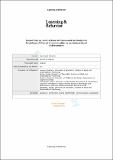Files in this item
Social play as joint action : a framework to study the evolution of shared intentionality as an interactional achievement
Item metadata
| dc.contributor.author | Heesen, Raphaela | |
| dc.contributor.author | Genty, Emilie | |
| dc.contributor.author | Rossano, Federico | |
| dc.contributor.author | Zuberbühler, Klaus | |
| dc.contributor.author | Bangerter, Adrian | |
| dc.date.accessioned | 2018-08-03T23:34:34Z | |
| dc.date.available | 2018-08-03T23:34:34Z | |
| dc.date.issued | 2017-12 | |
| dc.identifier | 250869284 | |
| dc.identifier | 6b0afea7-e5f7-4bfb-a5be-34ca7e432bf3 | |
| dc.identifier | 85026815638 | |
| dc.identifier | 000416836400010 | |
| dc.identifier.citation | Heesen , R , Genty , E , Rossano , F , Zuberbühler , K & Bangerter , A 2017 , ' Social play as joint action : a framework to study the evolution of shared intentionality as an interactional achievement ' , Learning and Behavior , vol. 45 , no. 4 , pp. 390-405 . https://doi.org/10.3758/s13420-017-0287-9 | en |
| dc.identifier.issn | 1543-4494 | |
| dc.identifier.other | ORCID: /0000-0001-8378-088X/work/64360682 | |
| dc.identifier.uri | https://hdl.handle.net/10023/15768 | |
| dc.description | The present research was supported by the Swiss National Science Foundation (Grant No. CR31I3_166331 awarded to AB and KZ). | en |
| dc.description.abstract | Social play has a complex, cooperative nature that requires substantial coordination. This has led researchers to use social games to study cognitive abilities like shared intentionality, the skill and motivation to share goals and intentions with others during joint action. We expand this proposal by considering play as a joint action and examining how shared intentionality is achieved during human joint action. We describe how humans get into, conduct, and get out of joint actions together in an orderly way, thereby constructing the state of “togetherness” characteristic of shared intentionality. These processes play out as three main phases, the opening (where participants are ratified and joint commitments are established), the main body (where progress, ongoing commitments, and possible role reversals are coordinated), and the closing (where the intention to terminate the action is coordinated and where participants take leave of each other). We use this process in humans as a framework for examining how various animal species get into, maintain, and get out of play bouts. This comparative approach constitutes an alternative measure of those species’ possession of shared intentionality. Using this framework, we review the play literature on human children and different social species of mammals and birds in search of behavioral markers of shared intentionality in the coordination of play bouts. We discuss how our approach could shed light on the evolution of the special human motivation to cooperate and share psychological states with others. | |
| dc.format.extent | 16 | |
| dc.format.extent | 570388 | |
| dc.language.iso | eng | |
| dc.relation.ispartof | Learning and Behavior | en |
| dc.subject | Communication | en |
| dc.subject | Cooperation | en |
| dc.subject | Joint action | en |
| dc.subject | Shared intentionality | en |
| dc.subject | Social play | en |
| dc.subject | BF Psychology | en |
| dc.subject | RC0321 Neuroscience. Biological psychiatry. Neuropsychiatry | en |
| dc.subject | Experimental and Cognitive Psychology | en |
| dc.subject | Cognitive Neuroscience | en |
| dc.subject | Behavioral Neuroscience | en |
| dc.subject | T-NDAS | en |
| dc.subject.lcc | BF | en |
| dc.subject.lcc | RC0321 | en |
| dc.title | Social play as joint action : a framework to study the evolution of shared intentionality as an interactional achievement | en |
| dc.type | Journal article | en |
| dc.contributor.institution | University of St Andrews. School of Psychology and Neuroscience | en |
| dc.contributor.institution | University of St Andrews. Institute of Behavioural and Neural Sciences | en |
| dc.contributor.institution | University of St Andrews. Centre for Social Learning & Cognitive Evolution | en |
| dc.identifier.doi | https://doi.org/10.3758/s13420-017-0287-9 | |
| dc.description.status | Peer reviewed | en |
| dc.date.embargoedUntil | 2018-08-04 |
This item appears in the following Collection(s)
Items in the St Andrews Research Repository are protected by copyright, with all rights reserved, unless otherwise indicated.

